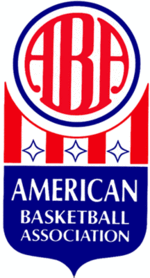American Basketball Association

The History of the ABA Part 1-6: Long Shots: The Life and Times of the American Basketball Association
 The American Basketball Association (ABA) was a professional basketballleague founded in 1967. The ABA ceased to exist with the ABA–NBA merger in 1976.
The American Basketball Association (ABA) was a professional basketballleague founded in 1967. The ABA ceased to exist with the ABA–NBA merger in 1976.
League history
The original ABA was founded in 1967, competing with the well-established National Basketball Association, until the ABA–NBA merger in 1976. According to one of the owners of the Indiana Pacers, its goal was to force a merger with the more established league. Potential investors were told that they could get an ABA team for half of what it cost to get an NBA expansion team at the time. When the merger occurred, ABA officials said their investment would more than double.
Ultimately, four ABA teams were absorbed into the older league: the New York Nets, Denver Nuggets, Indiana Pacers, and San Antonio Spurs. Two other clubs, the Kentucky Colonels, and the Spirits of St. Louis, were disbanded upon the merger. A third, the Virginia Squires, had folded less than a month earlier, missing out on the opportunities that a merger might have provided.
The ABA distinguished itself from its older counterpart with a more wide-open, flashy style of offensive play, as well as differences in rules – a 30-second shot clock (as opposed to the NBA’s 24-second clock, though the ABA did switch to the 24 second shot clock for the 1975-76 season) and use of a three-point field goal arc. Also, the ABA used a colorful red, white and blue ball, instead of the NBA’s traditional orange ball. The ABA also had several “regional” franchises, such as the Virginia Squires and Carolina Cougars, that played “home” games in several cities.
The ABA also cleverly went after four of the best referees in the NBA: Earl Strom, John Vanak, Norm Drucker and Joe Gushue, getting them to “jump” leagues by offering them far more in money and benefits. In Earl Strom’s memoir Calling the Shots, Strom conveys both the heady sense of being courted by a rival league with money to burn—and also the depression that set in the next year when he began refereeing in the ABA, with lesser players performing in inadequate arenas, in front of very small crowds. But the emergence of the ABA boosted the salaries of referees just as it did the salaries of players.
The freewheeling style of the ABA eventually caught on with fans, but the lack of a national television contract and protracted financial losses would spell doom for the ABA as an independent circuit. In 1976, its last year of existence, the ABA pioneered the now-popular slam dunk contest at its all-star game in Denver.
One of the more significant long-term contributions of the ABA to professional basketball was to tap into markets in the southeast that had been collegiate basketball hotbeds (including North Carolina, Virginia, and Kentucky). The NBA was focused on the urban areas of the Northeast, Midwest and West Coast. At the time, it showed no interest in placing a team south of Washington, D.C.
Commissioners
- George Mikan 1967–1969
- James Carson Gardner 1969 (interim)
- Jack Dolph 1969–1972
- Bob Carlson 1972–1973
- Mike Storen 1973–74
- Tedd Munchak 1974–75
- Dave DeBusschere 1975–76
NBA great George Mikan was the first commissioner of the ABA, where he introduced both the 3-point line and the league’s trademarkred, white and blue basketball. Mikan resigned in 1969. Dave DeBusschere, one of the stars of the New York Knicks championship teams, moved from his job as Vice President and GM of the ABA’s New York Nets in 1975 to become the last commissioner of the ABA and facilitate the ABA-NBA merger in 1976.

